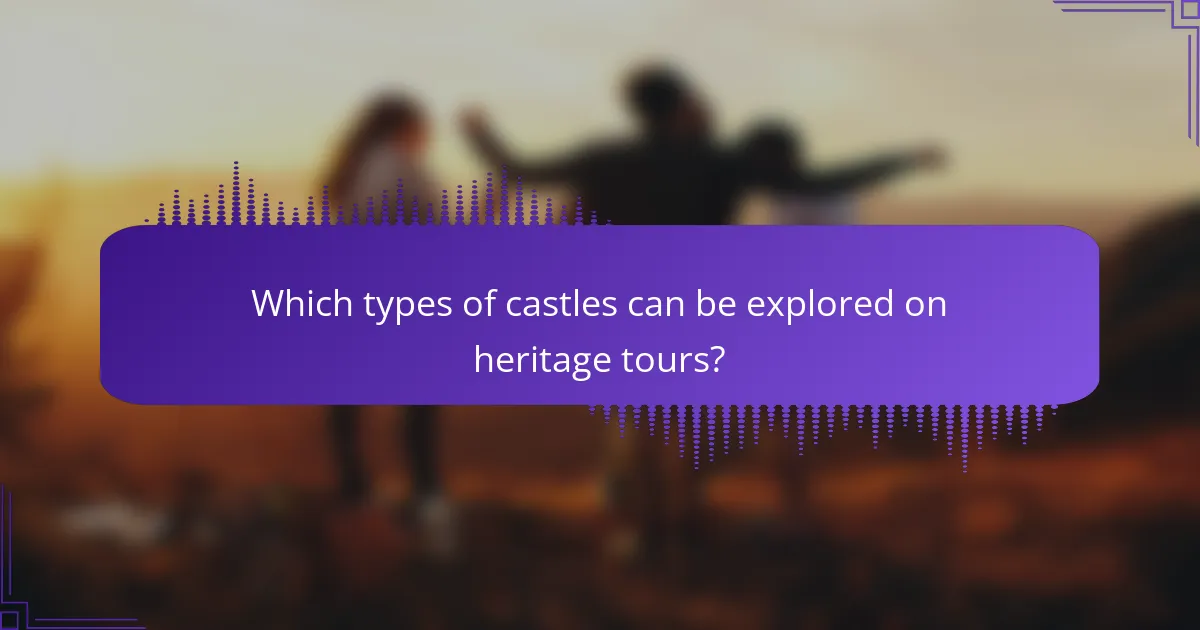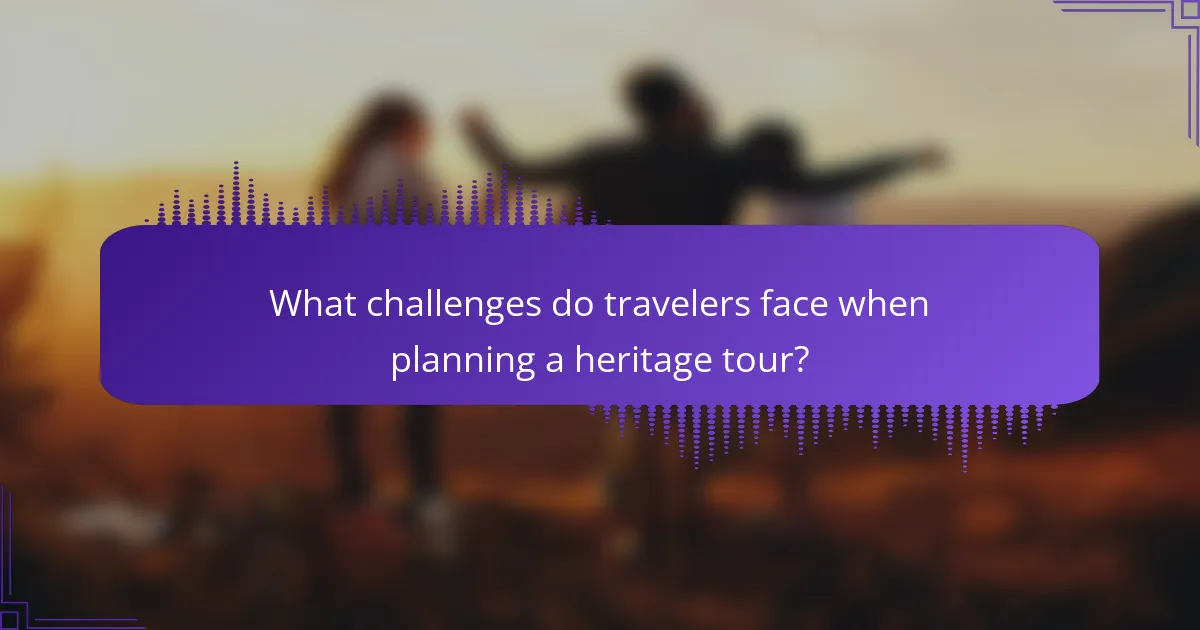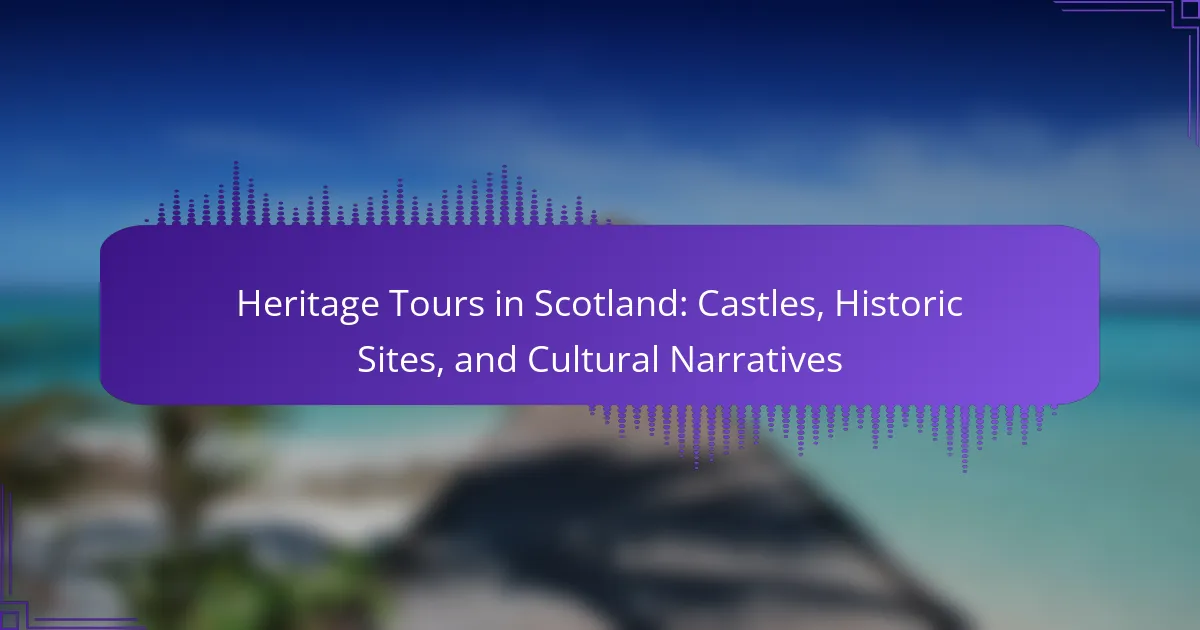Heritage tours in Scotland offer immersive experiences that connect travelers with the nation’s rich history. Explore iconic castles like Edinburgh Castle and Stirling Castle, visit significant historic sites, and engage with local cultural narratives. Discover guided and self-guided tour options that cater to diverse interests while navigating logistical challenges. Learn how heritage tourism benefits local communities and enhances cultural preservation.

What are the key features of heritage tours in Scotland?
Heritage tours in Scotland feature rich historical narratives, iconic castles, and significant cultural sites. These tours offer immersive experiences that highlight Scotland’s unique heritage.
Key features include:
– **Castles**: Explore majestic structures like Edinburgh Castle and Stirling Castle, showcasing architectural grandeur and historical significance.
– **Historic Sites**: Visit sites such as the Battle of Bannockburn and the ancient standing stones of Orkney, providing insight into Scotland’s past.
– **Cultural Narratives**: Engage with local stories and traditions, enhancing the understanding of Scotland’s diverse cultural landscape.
– **Guided Experiences**: Benefit from knowledgeable guides who share in-depth knowledge about history, architecture, and local customs.
– **Scenic Landscapes**: Enjoy breathtaking views of the Scottish Highlands and picturesque villages, adding visual appeal to the historical journey.
How do castles enhance the heritage tour experience?
Castles significantly enhance the heritage tour experience by providing immersive insights into Scotland’s history and culture. Their architectural grandeur and historical significance attract visitors, offering a tangible connection to the past.
Visitors can explore unique attributes like the intricate designs of castles, each reflecting different historical periods and styles. For instance, Edinburgh Castle showcases medieval military architecture, while Stirling Castle offers Renaissance elegance.
Additionally, castles often serve as venues for cultural events and reenactments, enriching the narrative of Scotland’s heritage. These experiences deepen understanding and appreciation of the nation’s rich history.
In summary, castles are not merely structures; they are vital storytellers of Scotland’s heritage, making tours more engaging and educational.
What historic sites are must-see destinations?
Scotland offers numerous must-see historic sites that showcase its rich heritage. Key destinations include Edinburgh Castle, a symbol of Scottish history, and the ancient standing stones of Callanish on the Isle of Lewis. Other notable sites are Stirling Castle, known for its role in Scottish battles, and the Palace of Holyroodhouse, the official residence of the monarch in Scotland. The ruins of Urquhart Castle on Loch Ness provide stunning views and legends, while the Neolithic village of Skara Brae in Orkney reveals insights into prehistoric life. Each site contributes to Scotland’s cultural narrative and attracts visitors seeking to explore its past.
Why are cultural narratives important in heritage tourism?
Cultural narratives are vital in heritage tourism as they enrich visitor experiences and foster a deeper connection to history. In Scotland, these narratives illuminate the stories behind castles and historic sites, enhancing their significance. They provide context, allowing tourists to appreciate the cultural heritage and traditions that shaped the landscape. Engaging with these narratives promotes understanding and respect for local customs, making heritage tours more immersive and meaningful. This connection to culture often leads to increased tourism revenue, benefiting local communities and preserving heritage for future generations.

Which types of castles can be explored on heritage tours?
Heritage tours in Scotland offer exploration of various castle types, including medieval fortresses, romantic ruins, and stately homes. Notable examples include Edinburgh Castle, Stirling Castle, and Eilean Donan Castle. Each castle showcases unique architectural styles and historical significance, enriching the cultural narrative of Scotland. Visitors can experience guided tours that highlight key events and legends associated with these historic sites.
What distinguishes medieval castles from Renaissance structures?
Medieval castles differ from Renaissance structures primarily in architectural style and purpose. Medieval castles emphasize defense, featuring thick walls and narrow windows, while Renaissance structures focus on aesthetics and symmetry, incorporating large windows and decorative elements. The transition reflects evolving societal needs, from feudal protection to cultural expression. Castles often served as military strongholds, whereas Renaissance buildings functioned as symbols of power and enlightenment.
How do local legends influence castle tours?
Local legends significantly enhance castle tours by enriching visitor experiences and deepening cultural connections. These narratives often shape perceptions of historical sites, making them more engaging and memorable.
Legends create an emotional resonance, allowing tourists to connect with the past. For example, stories of ghostly apparitions or legendary battles can add intrigue to a castle’s history. This storytelling approach fosters a unique atmosphere, drawing visitors who seek immersive cultural experiences.
Moreover, local legends often highlight unique attributes of specific castles. For instance, the tale of the Loch Ness Monster associated with Urquhart Castle attracts many tourists, enhancing its appeal.
As a result, heritage tours in Scotland leverage these narratives to attract visitors, promoting cultural tourism and preserving local traditions.

What unique cultural experiences can visitors expect?
Visitors can expect immersive cultural experiences that highlight Scotland’s rich heritage. Heritage tours offer unique access to ancient castles, historic sites, and local narratives.
These tours often include guided explorations of iconic landmarks such as Edinburgh Castle and Stirling Castle, where visitors learn about Scotland’s tumultuous history. Participants can engage with traditional Scottish music and dance, enhancing their understanding of local customs.
Culinary experiences are also a key feature, with opportunities to taste traditional dishes like haggis and whisky. These tours foster a deeper connection to Scotland’s cultural identity, making each visit memorable.
Additionally, some tours provide unique insights into local folklore and legends, showcasing rare stories that are not widely known. This blend of history, culture, and personal storytelling creates an unforgettable journey through Scotland’s past.
How do traditional Scottish festivals enrich heritage tours?
Traditional Scottish festivals significantly enhance heritage tours by providing immersive cultural experiences. These festivals showcase Scotland’s rich history, traditions, and local customs, allowing visitors to connect deeply with the nation’s heritage. Events like the Edinburgh Festival Fringe and the Highland Games highlight unique attributes such as traditional music, dance, and storytelling. These experiences create memorable narratives that enrich the understanding of Scotland’s cultural landscape, making heritage tours more engaging and informative. As a result, tourists gain a comprehensive view of Scotland’s identity through its festivals.
Which local artisans and crafts can be discovered?
Heritage tours in Scotland reveal various local artisans and crafts, including pottery, weaving, and woodworking. Visitors can discover unique tartan patterns, handcrafted jewelry, and traditional Scottish ceramics. Notable locations include Edinburgh’s Grassmarket and the Isle of Skye, where artisans showcase their skills. Each craft reflects Scotland’s rich cultural narratives and heritage.

What are the benefits of guided versus self-guided heritage tours?
Guided heritage tours offer personalized insights and expert narratives, while self-guided tours provide flexibility and independence. Guided tours often include access to exclusive sites and deeper cultural context, enhancing the overall experience. Self-guided options allow travelers to explore at their own pace, catering to personal interests. Each choice has unique benefits, depending on the traveler’s preferences for structure versus spontaneity.
How do expert guides enhance the understanding of history?
Expert guides significantly enhance the understanding of history by providing in-depth knowledge and context. They connect visitors to Scotland’s rich heritage through storytelling, making historical events and figures relatable. Expert guides also share unique insights about castles and historic sites, revealing lesser-known facts that deepen appreciation. Their expertise fosters a more engaging experience, transforming a simple tour into an immersive cultural narrative.
What are the advantages of exploring at your own pace?
Exploring at your own pace during heritage tours in Scotland offers flexibility, deeper engagement, and personalized experiences. Visitors can immerse themselves in the rich history of castles and historic sites without the pressure of a fixed schedule. This approach allows for meaningful interactions with cultural narratives, fostering a stronger connection to Scotland’s heritage. Additionally, travelers can choose to spend more time at locations that resonate with them, enhancing their overall enjoyment and understanding of the sites visited.

What challenges do travelers face when planning a heritage tour?
Travelers face various challenges when planning a heritage tour in Scotland, including logistical issues, cultural understanding, and budget constraints.
Logistical challenges often involve transportation and accommodation. Heritage sites may be remote, requiring careful planning of travel routes and booking of stays.
Cultural understanding is essential, as travelers may need to navigate local customs and historical contexts to fully appreciate the significance of sites like castles and historic landmarks.
Budget constraints can limit options for tours and experiences, making it vital for travelers to research affordable alternatives that still offer rich cultural narratives.
How can weather conditions impact tour experiences?
Weather conditions significantly influence heritage tour experiences in Scotland. Rain can create a mystical atmosphere around castles, enhancing the historical narrative. Conversely, sunny days allow for clearer views and more comfortable exploration of historic sites. Seasonal variations also affect visitor numbers; summer often sees larger crowds, while winter offers a quieter, more intimate experience. Additionally, weather impacts accessibility to some sites, as heavy rainfall may lead to temporary closures or altered paths. Understanding these factors helps travelers plan their tours effectively.
What are common misconceptions about heritage tours?
Many believe heritage tours in Scotland are only for history buffs, which is a misconception. These tours offer diverse experiences for all interests, including stunning landscapes and rich cultural narratives. Another common myth is that they are overly expensive; however, many affordable options exist. Some think heritage tours lack engagement, but interactive elements like storytelling and local guides enhance the experience. Lastly, people often assume these tours are limited to castles, while they actually encompass a wide range of historic sites and cultural experiences across Scotland.

How does heritage tourism impact local communities?
Heritage tourism positively impacts local communities by enhancing economic growth and cultural preservation. It generates revenue through visitor spending at castles and historic sites, creating jobs and supporting local businesses. Additionally, it fosters community pride and awareness of cultural narratives.
Local communities benefit from infrastructure improvements, driven by increased tourist demand for amenities. This can lead to better roads, public transport, and services, ultimately enhancing residents’ quality of life. Moreover, heritage tourism promotes the safeguarding of historical sites, encouraging conservation efforts that maintain the integrity of local heritage.
As a result, communities often engage in storytelling and cultural events, enriching the visitor experience while strengthening their identity. The unique attributes of Scotland’s rich history and diverse cultural narratives attract tourists, making heritage tourism a vital part of community development.
What economic benefits do heritage tours bring?
Heritage tours in Scotland generate significant economic benefits by boosting local tourism and creating jobs. They attract visitors to castles and historic sites, stimulating spending in restaurants, hotels, and shops. For example, heritage tourism contributes approximately £1.5 billion annually to Scotland’s economy. This influx supports local communities and preserves cultural narratives. Additionally, heritage tours promote sustainable tourism practices, ensuring long-term benefits for both the economy and heritage conservation.
How can tourism support the preservation of historical sites?
Tourism can significantly support the preservation of historical sites by generating revenue that funds conservation efforts. Heritage tours in Scotland, featuring castles and historic sites, attract visitors who contribute to local economies. This financial influx enables ongoing maintenance and restoration projects, ensuring these cultural narratives remain intact for future generations. Moreover, increased awareness fosters community engagement, encouraging locals to advocate for preservation initiatives. As a result, tourism becomes a vital tool in safeguarding Scotland’s rich heritage.

What are the best practices for choosing a heritage tour?
To choose the best heritage tour in Scotland, focus on well-reviewed options that highlight castles, historic sites, and cultural narratives. Research tour operators’ reputations, customer feedback, and the depth of cultural experiences offered.
Consider the duration and itinerary of tours, ensuring they cover significant landmarks like Edinburgh Castle and the Isle of Skye. Look for tours that provide knowledgeable guides who share engaging stories about Scotland’s history.
Evaluate the group size; smaller groups often allow for a more intimate experience. Lastly, check for any unique features, such as exclusive access to certain sites or themed tours that align with personal interests.
How can travelers select tours that align with their interests?
Travelers can select heritage tours in Scotland by considering their specific interests in castles, historic sites, and cultural narratives. Research tours that highlight personal passions, such as architecture or local legends.
Look for tours that offer unique experiences, like private access to lesser-known castles or guided narratives from local historians. Reviews and testimonials can provide insight into how well a tour aligns with personal interests.
Additionally, consider the duration and format of the tours, as some may focus on immersive experiences while others may be more informational.
Lastly, check for any rare attributes, such as themed tours that celebrate specific historical events or figures, to enhance the travel experience.
What resources are available for planning a heritage tour?
To plan a heritage tour in Scotland, utilize a variety of resources. Start with official tourism websites that provide detailed itineraries and recommendations for castles and historic sites. Travel guides offer insights into cultural narratives and local history. Online forums and social media groups can connect you with other travelers for personal experiences and tips. Consider guided tours for expert knowledge and convenience. Local visitor centers also provide maps, brochures, and event schedules to enhance your experience.
What common mistakes should travelers avoid when booking tours?
Travelers should avoid common mistakes such as failing to research tour operators, overlooking cancellation policies, and not reading reviews. Ensuring a thorough understanding of itineraries and inclusions is crucial for heritage tours in Scotland, which feature unique attributes like access to lesser-known castles. Additionally, booking last minute can limit options and lead to higher costs.
